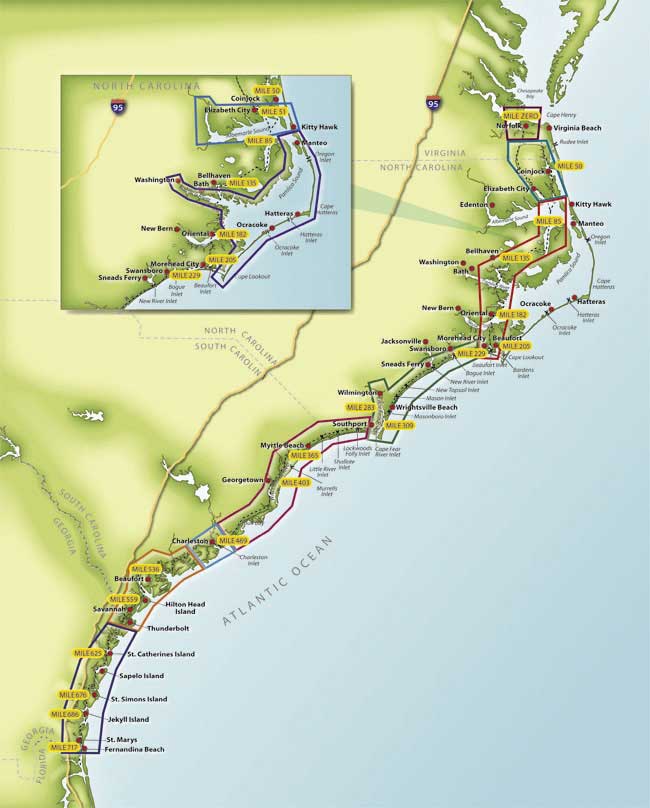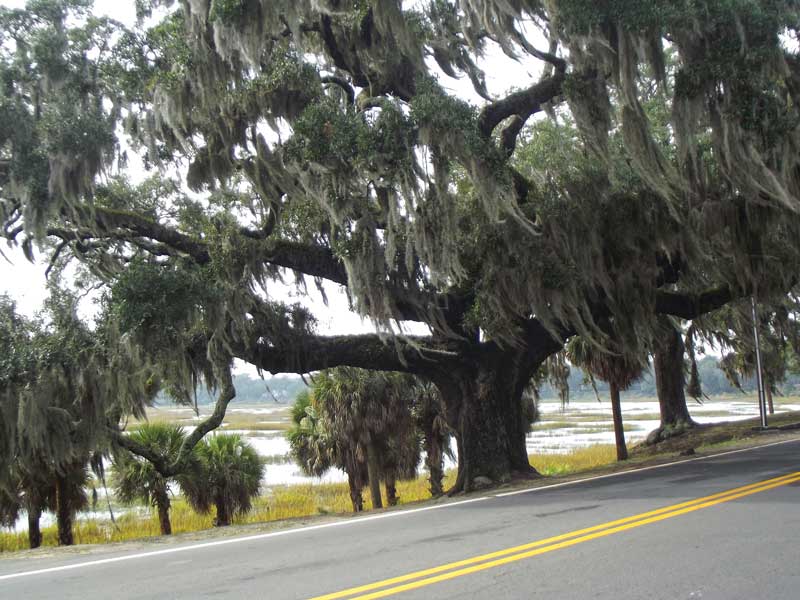A trip down the Intracoastal Waterway (ICW) is easier than you might expect. It is nothing more than a series of day trips, about 30 of them, all strung together. You are never far from help, but with planning and preparation, you will arrive in the turquoise water with no delays.

There are two distinct phases of getting your boat ready for such an adventure. The first is to prepare the boat that you have. It is easy to be carried away looking at the coveted, new toys you want for your boat: new electronics, anchor, dinghy, and engine. But first, assess and prepare the boat you have right now. A trip down the ICW, a few months cruising down south, and then returning to the Bay, will put five times as many hours on a boat as a normal boating season on the Chesapeake.
All your existing systems—fresh water, sewage, propulsion and shaft seals, anchoring, navigation—will be used like never before. These systems have to be in top shape and ready for the trip before you start buying new toys. Start the trip with the engine freshly serviced. Change the oil, the transmission fluid, and the antifreeze. Install a new cooling water impeller and have another in reserve. Know how to change fuel filters, bleed the fuel system, and change the water pump impeller on your own.
Now look over the machinery carefully: Do you see any signs of rust, corrosion, or water or oil leaks? Three out-of-the-ordinary failures I see include dirty fuel in an old tank, restricted exhaust elbow causing overheating or exhaust hose burn out, and raw water pump seal failure. These failures will give signals that repairs are needed, but if the signals are missed, the boat will be out of commission. Catch this before you take off.
Spare Parts
Along the ICW, spare parts are easy to find, but there are some cruise stoppers:
- A failed head is one definite problem. Be sure to have a rebuild kit, so that you can repair it on the spot and keep moving south.
- The fresh water pump is simple and reliable, but if it fails, you have to stop. Carry a rebuild kit or a complete new pump because some manufacturers’ replacement pumps are hard to find.
- Check your batteries. If they are getting old, replace them before you start. You will be cycling them many more times before you arrive in the warm turquois water than you ever would cycle them in a season of Bay cruising.
- If your boat has been cruising on the Bay for 10 years or more, fuel polishing might be a very good idea before you go.
- Learn diesel engine basics: how to change fuel filters (carry spares), bleed the fuel system, and change water pump impeller on your own.
- You don’t have to have a spare for everything, but you must plan for those parts which might not be in stock in a parts store.
- One simple but often overlooked system is dock lines and fenders. You will need to have at least two very long dock lines of at least 50 feet. Fender boards are a necessity in the locks and in marinas along the way.

Anchor & Dinghy
What anchor will work best? The anchor you use on the Chesapeake is the best one for the ICW, too, but be sure to have a second anchor of a different style. In the ICW you will often anchor with swifter currents and less protection than we are used to here on the Bay. You will use greater scope ratio. Having a windlass will turn out to be mighty important for the enjoyment of your trip. If you are buying new chain, be certain that it matches the windlass chain gypsy. A 5/16” in galvanized chain is a common size for 35-40 foot boats. But there are three different link lengths, and the chain has to match the gypsy or it will not work.
Now is the time to mark your anchor rodes. There is no need for a complicated marking system. If you mark your rode in four or five places, it will be adequate for your needs. First mark the rode at 100 feet. That will be a 7:1 ratio in 10 feet of water (for a rope rode, assume the bow roller is five feet off the water). Another mark at 150 feet will give you 7:1 in about 15 feet of water. A mark at 200 feet will give you 7:1 ratio in 23 feet of water. A mark at 250 will set your scope for anchoring in 30 feet of water. A simple marking system is all you need; it is easier to remember what each set of mark means rather than a complicated system where the rode is marked every 10-20 feet.
What kind of dinghy do you need? The dinghy you have on the Chesapeake will work for you anywhere. Remember to service the engine before you go. In the ICW you may rarely use your dinghy, but that will change when you get to the winter cruising grounds. You will travel at times with little protection from the open Atlantic and in rougher weather than we see on the Bay. There will be days where towing it is just not an option. It has to be easy to deploy and retrieve your dinghy.

Cruising Guide
Select a cruising guide. Yes, a paper guide will be extremely useful. The On the Water Chart Guides CruiseGuide for the ICW is essential. There are other guides which cover the shopping and restaurants along the way (and so does Google), but this guide is a mile-by-mile, turn-by-turn piloting guide. Plan 40- to 50-mile days. The weather is less predictable in the fall, so always have a fallback harbor in mind in case the wind pipes up and you have to stop short for a day. The whole purpose of this cruise is to see new places. So don’t overbook yourself; leave plenty of layover days to explore.

Practice & Departure
Before you depart for your winter cruising grounds, you really should do an eight- to 10-day cruise here on the Chesapeake. Run the boat for a couple of long days to be sure the systems are running well. Run the engine for eight hours at high cruising speed. Be sure the temperature is stable and the filters remain clean. Anchor somewhere in strong current to be sure you are confident of your equipment and skills: Chestertown is a great place for this. Deploy and retrieve your dinghy to be sure you can do it efficiently when conditions require it. Before you know it, it will be time for your departure. If you have fully prepared your boat, the departure will be exciting but almost anti-climactic as you head out toward Hampton Roads and the far horizon. One last thing to check: be sure you have plenty of boat cards. You are going to meet a lot of cruisers, and your paths will cross time and again.